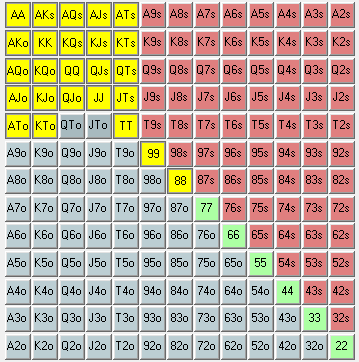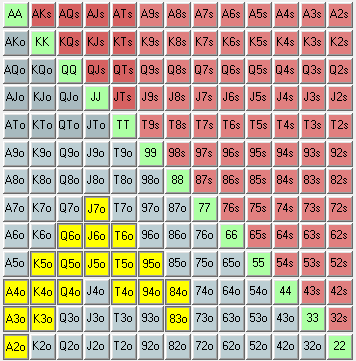We’ve all probably watched some spicy heads-up action on those high stakes where it seems that two opponents are 3-betting each other all the time. You might think to yourself, how can he always be dealt such good hands? Well, obviously, he isn’t. Heads-up poker can get very personal, and you want to out-level your villain as much as possible. So they often raise with hands they rather not want to play the flop with, and call, or as they call it, ‘slowplay’, when they do have an actual good hand. But enough about the high stakes. We are here to learn and hopefully get to those stakes eventually!
3-betting is essential in heads-up. If you don’t 3-bet, you’ll get runned over by your villain and will lose a lot of money. In heads-up you either 3-bet for value or as a bluff. This depends on how your villain plays. Your 3-bet range should be between 10-15% up to 20%. It’s important to maintain a bit of an aggressive image for your villain. This way won’t run over you.
A quick example of a 3-bet range (highlighted in yellow):
This is about 13% of hands. As you can see, almost all of these hands are for value. Usually when you start a game with a new villain, you should begin with a 3-betting range that looks like this.

3-Betting weak hand as a bluff
When you start to get comfortable 3-betting, and have a bit more experience, you can start 3-betting some hands that don’t play very well on the flop. For instance, J6o, or Q7o, hands like those. The more your villain folds to 3-bets, the wider that range can be, just to pick up the pot pre-flop. You 3-bet these kind of hands, because you can’t really call with them, nor do they play well on the flop. For instance, a ‘bluff’ 3-bet range could look like this; keep in mind that this may vary a lot, depending on how your villain acts to your 3-bet behavior.

This is just an example, but if your villain is really passive and doesn’t play back at your 3-bets at all, you can widen this range all the way up to something that looks like this;

Keep in mind that this is only a 3-bet bluffing range, you need to add your value range as well. This last example is also an extreme case and you won’t often get a villain that is this passive. So please don’t think this is the optimal way to 3-bet your villains at the start. I’m just giving an example on how you should adjust.
On the other hand, you should also keep in mind, that if your villain is very aggressive and starts 4-betting you a lot or just calls your 3-bets a lot, you should tighten your range. You can’t really make a lot of 3-bets as bluff. Simply because of the fact that he will 4-bet you and you have to fold, or he will call you, and you must play a flop with a very weak hand. It’s very important to keep an eye on these things during the game, to always stay one step ahead of your villain.
What should your sizing be when you 3-bet?
Normally I 3-bet about 3 times the amount of the last made bet. For instance. SB opens 3x the BB in a $1/$2 game, so that makes $6. It’s recommended to 3-bet around 3 times the bet, so that should be between $15-$21. This are between a total of 7.5 – 10.5 big blinds.
It is important to stay consistent in your 3-bet sizing. For instance, if you 3bet to 8 big blinds as a bluff, and to 10 big blinds for value, your villain will start noticing that, and will use it against you. So make sure once you decided to 3-bet to a certain amount, to keep 3-betting that same amount later on.


